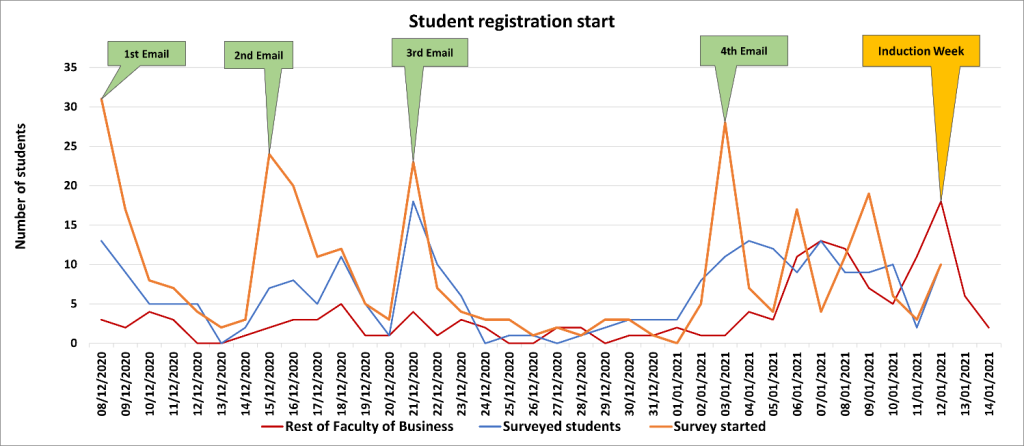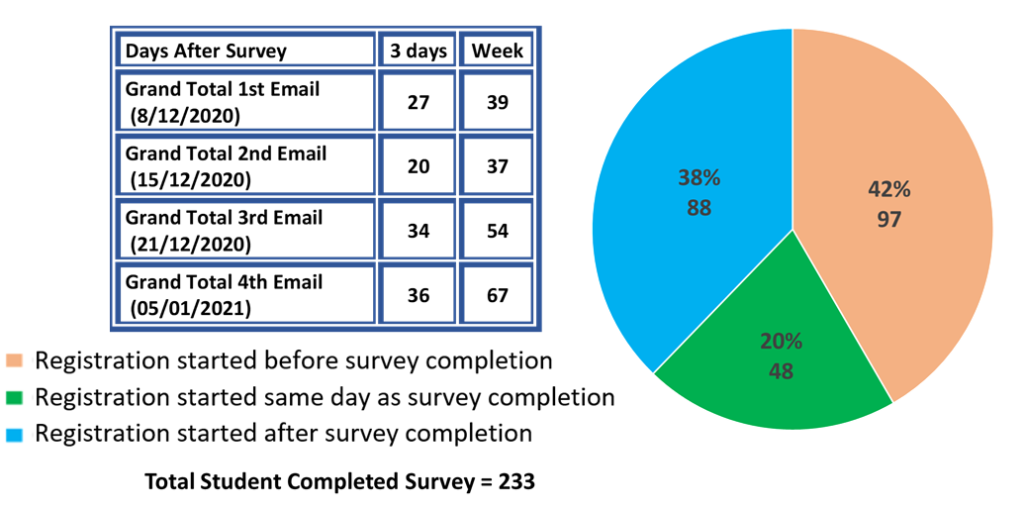The onboarding process is essential for the success of students at university: the start to university life and academic study are a unique and challenging experience. The faster a student settles in and learns new systems, the more engaged they become (Grillo & Kim, 2015). During the Covid-19 pandemic many HE educators have faced deteriorations in incoming students’ engagement levels (McKie 2020). A few key factors have contributed to this such as the use of online platforms and reduction in or lack of face-to-face teaching. The absence of face-to-face teaching has transformed students’ lives, students have been unable to interact with their peers in person. These factors have all contributed to students feeling isolated and not engaged with their programmes.
The following reports on a new process we implemented at the University of Greenwich in order to improve incoming students’ experiences and help them settle in when they start with us. We concentrated on students and placed them at the centre of all our improvements. As part of this process we looked at the existing system and found ways that we could improve it. We focused on three areas: “Pre-induction”, “Induction” and “Post-induction” with a cohort of predominantly international postgraduate students undertaking study in the UK for the first time.
As a starting point pre-induction, we looked at initial communications with applicants from our departmental programme co-ordinator, faculty and central university teams in order to identify areas to move beyond one-way communication and involve students more directly prior to their enrolment. We devised an online survey on Microsoft Forms which the programme coordinator sent to all eligible applicants from our generic programme inbox. In the survey, we gathered information on a range of questions including student status, registration status, plans on arrival in the UK and for COVID preparation, their preferred mode of study (online or face to face). This allowed us to gather information and plan our resources accordingly. We were also able to rectify any record issues and registration problems that students had stated in their responses. This process also provided students with a point of contact to come to if they needed guidance. We sent a weekly reminder to students that had not participated in our survey, which we continued until the end of induction week. Induction information was then sent to all students a week before their scheduled induction, including those who hadn’t completed the survey but had received a reminder to do so.
We made changes to our induction by introducing additional training sessions to show students how to use our systems such as the university portal, Moodle, timetable as well as information on central university services. Students also met their personal tutor during induction week in a two-hour session where they could ask any questions and get to know their personal tutor and their peers. Feedback from our termly planned programme meeting with student representatives validated that students were happy with these additional training sessions and opportunities as well as meeting their personal tutor early on in order to prepare themselves for university life at Greenwich.
Changes to pre-induction and induction benefited our post-induction process whereby we were able to reduce the number of late arrivals. Previously, we have had lots of students arriving post-induction and missing important information and repeat inductions were too impractical to organise. With our new system, we were able to process new applicants more speedily and reduce the number of late arrivals, thereby gaining time to provide a mini-induction; we arranged one- to-one meetings with students to bring them up to speed with what they had missed.
Our new onboarding process also resulted in timetabling improvements; students were able to register earlier and receive their personalised timetable before it was processed on the wider university system. This meant that their tutor groups were created early and tutors had their class lists ready, which enabled them to identify anybody who was not engaged, and the retention team could also start monitoring attendance.
The benefits of the new process:

In order to measure how effective this new system was we looked at our students’ registration data. We looked at the actual date that students started their registration. We noticed that there were some spikes in data and where some days saw an increase in the number of students starting their registration. We compared these dates with our weekly reminders, and we could see they coincided. In order to rule out any underlying factors we compared the data with the rest of the Faculty of Business and we could see there was a positive correlation between the survey completed and the start of registration on the affected programmes. While our priority was students settling in early, from a planning and resource point of view, early registration is also beneficial for the university as it limits the need for last minute staffing and resources. The graph below shows this data.

Following a further check on students who had started their registrations, we found that the survey worked as we had 20% of students starting their registration the same day as the survey. In addition, on average our surveys encouraged 30 students to start their registration within 3 days of receiving it.

We aimed to improve student onboarding and the first step for applicants is to start their registration and become students. Our survey and weekly reminders encouraged students to start their registrations and their journeys as students. Different ways that we can recognise how effective our approach was is to compare the January 2021-22 students’ registration data with the previous year’s intake. We looked at the number of students who had started their registration before the first week of teaching and the data shows that our approach had a significant effect and there was an 8% increase in the number of students that started their registration. This translated into planning an extra tutorial or seminar for all the modules on the programme which requires additional classrooms, teaching staff and resources.

Knowing the additional information that we gathered from surveying the students allowed us to improve students’ allocations to tutorial groups. We made sure that our groups were gender and domicile balanced, which provided students with a better experience on their programme. Also, in the Covid-19 pandemic, we had the benefit of knowing who needed to study online and who was not currently in the UK, we provided them with earlier or later tutorials to match their time zone.
Overall, our new approach was well received by our students and staff as they all had a more solid start to their journey at the University of Greenwich. Personal tutors managed to have an excellent bonding with their tutees in the induction and students benefitted from additional training and the fact that they knew the programme coordinator and could contact them if they faced any difficulties. We continued with our work in our April 2021 start of the programmes and made more changes to induction by adding two additional sessions: Greenwich Students’ Union ran an introduction session for our students, and we added a Placement session for our students.
Going forward we want to expand this approach across other undergraduate programmes in our department with a view to extending it to the rest of the School.
Sarvin Hassani, Teaching Fellow (Business School), University of Greenwich
Eleanna Spyrou, Programme Administrator (Business School), University of Greenwich
References